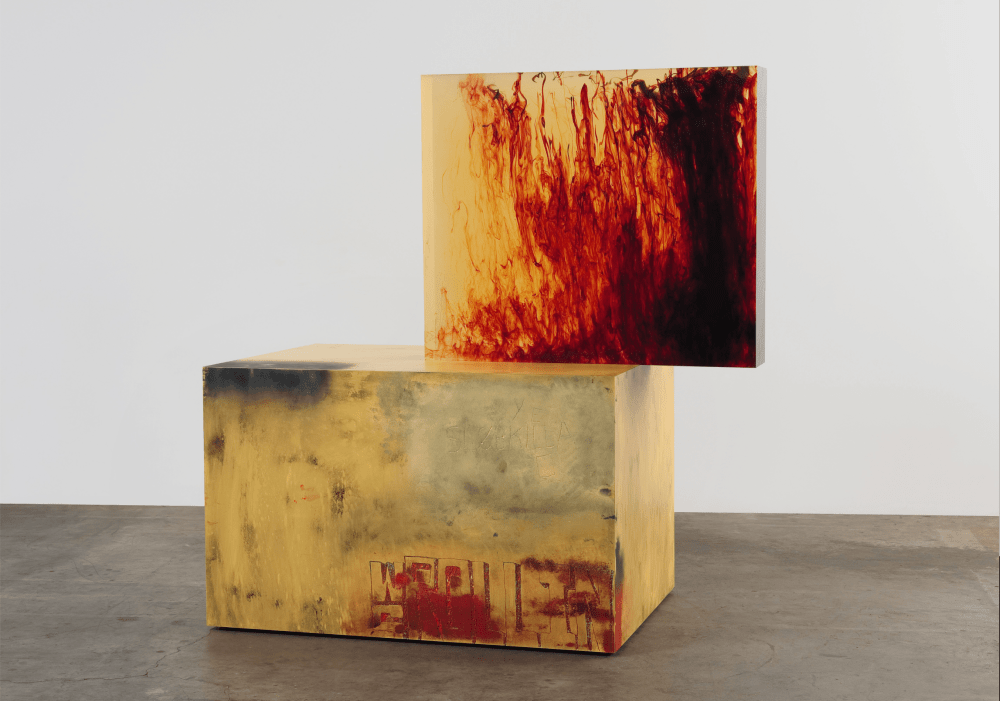
Sterling Ruby’s Acts/WS Rollin (2011), clear urethane block, dye, wood, spray paint, and Formica. Photo by Robert Wedemeyer/Collection of Institute of Contemporary Art Miami/Courtesy of Sterling Ruby Studio
It’s hard to think of an artist who’s having more of a moment than Sterling Ruby. The Los Angeles-based discipline straddler — think painting, ceramics, collage, photography, video, textiles, sculpture, etc. — has accrued fittingly wide-ranging clout thanks to the launch of his fashion line, S.R. Studio. LA. CA. Coming after a decade’s worth of collaborations with the name-checked-in-rap-songs designer Raf Simons and years of making his own clothes for personal use, the label’s debut at the Pitti Uomo fashion trade show this year in Florence was met with massive acclaim in the fashion press. According to a recent New Yorker profile, 30 percent of the collection was sold within two days of the show.
“I think that his taking on a fashion label and dedicating so much time to it is another way of sharing his voice and another way of challenging what an artist can be in this day and age, and I think it’s a really interesting and radical step,” says Alex Gartenfeld, artistic director at the Institute of Contemporary Art Miami (ICA).
In light of Ruby’s newfound star status, the ICA’s staging of a Sterling Ruby retrospective would appear to represent the epitome of perfect timing. In reality, the exhibition, which opens November 7 and runs through February 2, has been in the works for quite some time: Co-presented with the ICA Boston and planned over four years with input from the artist, it will be the first show to take over both the second and third floors of the museum’s main building in the Design District since the venue opened in 2017.
In other words, this will be the biggest exhibition ICA Miami has ever staged.
The pieces on display at the ICA run the span of the 47-year-old artist’s oeuvre, jumping from medium to medium seemingly at will. Having spent much of his career in the Los Angeles County industrial town of Vernon, Ruby has incorporated plenty of bizarre materials into his works.
The results are a feast for the eyes: massive stalagmites made of hardened polyurethane; huge fabric installations; large-scale expressionist spray paintings; collages made from scraps of denim doused with bleach; and gonzo sculptures made from discarded Hollywood props. When Gartenfeld describes Ruby’s art as “diverse in terms of production but also monumental in terms of scale,” he’s not kidding.
These disparate objects are linked together by two major themes, both of them outside of the usual art-world inspiration points. One is craft, which comes out in Ruby’s use of fabric. The artist, who grew up in rural Pennsylvania, has often cited his Amish neighbors’ quilting projects as an influence.
The second, much darker, theme, is the U.S. prison system. Ruby has long been interested in examining the prison-industrial complex, going back to “Supermax 2008,” his breakthrough museum show at the Los Angeles Museum of Contemporary Art. A recent video piece, State, features helicopter footage of California’s prisons. At the ICA, the fixation is most visible in Big Yellow Mama, a replica of Alabama’s infamous electric chair, which was last used in 2002 but is still in service.
“We’re specifically interested in how the artist has taken on the figure of the outsider and expressed his interest in craft, as well as the notion of the inmate or the prisoner,” Gartenfeld says. “Sterling is an artist who is deeply interested in the idea of the artist as ‘outsider,’ as a way of thinking about and critiquing contemporary culture.”
Ruby himself is something of an outsider in the art world. He funds all of work and negotiates contracts with several galleries rather than choosing to be represented by a single one. Even before he launched his ready-to-wear brand, during his collaborations with Raf Simmons, Ruby caught flak from his sellers for stepping out of the box. Now, with his fashion line a success and this major museum show likely to cement his reputation as a preeminent artist of our era, there’s not much more his critics can say.